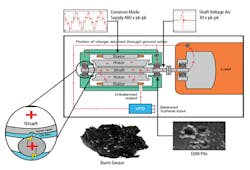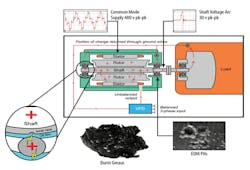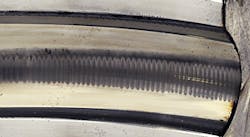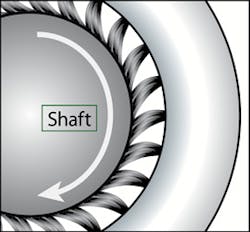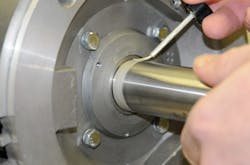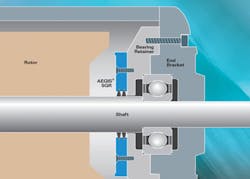By Adam Willwerth
Until all motors are designed with built-in bearing protection, plant maintenance personnel and motor repair shops will continue to replace damaged bearings. However, if a motor's bearing problem is fixed properly and appropriate mitigation is installed, it only needs to be done once. Even better, informed technicians can utilize the latest diagnostic techniques (vibration analysis, thermography, shaft-voltage testing, etc.) to avoid electrical bearing damage from the start. Here are some best practices for a brand new motor or one already in service.
The Problem: Electrical Bearing Damage
Variable frequency drives (VFDs, also known as inverters) can save 30 percent or more in energy costs. As such, they have been cited as a key technology for those intending to make their processing plants, automated assembly lines, HVAC systems, and other equipment more energy- efficient (or "green"). Unfortunately, whether used to control a motor's speed or torque, VFDs often induce voltages and currents that can damage bearings. In fact, the costly repair or replacement of failed motor bearings can eliminate any savings a VFD yields and severely diminish the reliability of an entire system.
The Causes
Bearing failure rates vary widely, but evidence suggests that a significant portion of these failures occur only three to 12 months after system startup. Because many of today's motors have sealed bearings to prevent dirt and other contaminants, electrical damage has become the most common cause of bearing failure in AC motors with VFDs.
The high switching frequencies of today's VFDs produce parasitic capacitance between a motor's stator and rotor. By now it is widely understood that once the resulting shaft voltages overcome the dielectric properties of bearing grease, they discharge along the path of least resistance -- typically through the bearings (see Fig. 1).
These discharges are so frequent that they create millions of tiny fusion craters. Before long, the entire bearing race wall can become marked with countless pits known as frosting. A phenomenon known as fluting may occur as well, shaping the frosting into washboard-like ridges across the bearing race (see Fig. 2). This causes noise, vibration, increased friction, and catastrophic bearing failure.
Types of Damage
As the bearings degrade, the tiny metal particles originating from the fusion craters intensify friction and abrasion, heat up the bearings and burn the contaminated grease. Too often, the end result is bearing failure and costly, unplanned downtime.
Understanding the Damage
Cutting and carefully inspecting the bearings of motors needing repair will often provide information that can be used to prevent a recurrence of the problem. Following established safety precautions, technicians should:
- Inspect the bearing cavity, retaining a sample of the grease in case further analysis is warranted to detect contaminants, signs of excessive heat, etc.
- Cut the outer race in half.
- Clean the bearing's components with a solvent.
- Inspect the race walls with a microscope for electrical pitting/frosting/fluting.
Protecting Motors for the Long Term
If inspection of the old bearing indicates electrical damage, the most reliable and cost- effective way to protect replacement bearings is to install a modern shaft grounding ring. Unlike older, single-point contact brushes, these rings completely surround a motor's shaft with contact points. Conductive microfibers should line the ring's entire inner circumference, boosting the electron transfer rate (see Fig. 3). A properly-installed ring provides a very low impedance path from shaft to frame, safely bleeding off damaging voltages to ground and bypassing the motor's bearings entirely. And because the microfibers work with little or no contact, they do not clog up and wear out like conventional grounding brushes.
A growing number of forward-looking motor manufacturers have recently added a factory-installed shaft grounding ring as a standard or optional feature on certain models, but they are still exceptions to the rule. Many industrial supply houses and distributors of motors and bearings sell grounding rings that can be installed on new, refurbished or in-service motors.
Tips & Tricks for Ring Installation
To maximize a grounding ring's effectiveness, all electrical paths must be conductive. Paint on the motor's faceplate must be removed. Likewise, the motor's shaft must be clean down to bare metal. Even after scrubbing with emery cloth, wiping the shaft with a non-petroleum-based solvent will remove unseen residues. After cleaning, the conductivity of the shaft should be checked with an ohm meter. If the reading at the section that will contact the ring's microfibers is higher than two ohms, the shaft should be cleaned again.
A grounding ring should never operate over a shaft keyway, which has sharp edges and could reduce conductivity. On some motors, the dimensions of the spacer and mounting screws can sometimes be adjusted/changed to avoid a keyway. If this is not feasible, the portion of the keyway that will contact the ring's microfibers should be filled with epoxy putty.
Conductivity should be further enhanced by lightly but evenly coating with colloidal silver any portion of the shaft that will contact the ring's microfibers. This will also help retard corrosion (see Fig. 4).
Threadlocking gels and liquids other than conductive epoxy are not recommended for the screws that mount the ring to the motor, as they might compromise the conductive path to ground.
The ring should be centered on the motor shaft so that its microfibers contact the shaft evenly.
When mounting the ring externally to an end bracket, split rings designed to slip around an in-service motor's shaft instead of over its end simplify installation.
After installation, testing with an ohm meter is again recommended. The best method is to place one probe on the ring and one on the motor frame. (The motor and drive must be grounded to common-earth ground in accordance with applicable standards.)
Variations on a Theme
For environments where the motor will be exposed to excessive amounts of dirt, dust or other debris, it may be necessary to protect the ring's fibers with an O-ring or V-slinger. Bearing isolators with built-in circumferential grounding rings are also available. For severe-duty environments such as many mining applications, however, mounting the shaft grounding ring inside the motor provides the best protection from contamination (see Fig. 5). Using conductive epoxy or screws, the ring can be mounted directly to a bearing retainer. An additional machined spacer will keep the ring away from the bearing grease cavity. Metal-to-metal contact is still essential, so the bearing retainer must be free of any coatings or other nonconductive material where it will touch the ring.
As for horizontally- or vertically-mounted motors with horsepower of 100 (75 kW) or less and single-row radial ball bearings on both ends, a shaft grounding ring can be installed on either end. For horizontally-mounted motors with horsepower greater than 100 and single-row radial ball bearings on both ends, the bearing housing at the nondrive end must be electrically isolated to disrupt circulating currents. Options for achieving such isolation include insulated sleeves, nonconductive coatings, ceramic bearings, or hybrid bearings. The grounding ring should be installed at the drive end.
For any motor in which the bearings at both ends are already insulated, the drive end is preferred for installation of a grounding ring to protect bearings in attached equipment such as a gearbox, pump, fan, or encoder.
For any motor with cylindrical roller, Babbitt or sleeve bearings, the end with such bearings should be electrically isolated, and the grounding ring should be installed at the opposite end.
Protection Should Start at Installation
Measuring shaft voltage on a VFD-driven motor provides valuable information for determining whether there is a risk of electrical bearing damage. The best time to take such measurements is during the startup of a new or recently- repaired motor. Every motor has its own unique parameters. Combined with vibration analysis, thermography or other diagnostic services, results (including saved oscilloscope-screen images) can be presented in a report to the supervisor/customer. Results should then be used in developing preventive and predictive maintenance programs.
Shaft voltages are easily measured (using appropriate safety procedures) by touching an oscilloscope probe to the shaft while the motor is running. The best probe will have a tip of high-density conductive microfibers to ensure continuous contact with the rotating shaft. A portable oscilloscope with a bandwidth of at least 100 MHz should deliver accurate waveform measurements. Probe/oscilloscope kits are available.
Confirming That Motors Are Protected
Just as shaft voltage measurements can show that a motor's bearings are in danger of electrical damage, they can also confirm that a shaft grounding ring is working. If a proven ring has been properly installed, typical discharge voltage peaks should be less than 10 volts.
Getting the Most From Your Motors
In summary, end users of VFD- driven motors have every right to expect uptime and reliability. After all, VFD- induced electrical bearing damage can now be prevented, not just repaired. Routine inspection, testing and analysis can provide advance warning and insight into the problem, and when bearings fail, proper repair practices can fix the problem for good. Motor shaft grounding rings, such as AEGIS® Bearing Protection Rings, can be installed during motor repairs or on new motors before they are put into service.
About the Author: Adam Willwerth, sales and marketing manager for Electro Static Technology, has extensive experience in industrial product development. He is named on four patent applications pertaining to conductive microfiber shaft grounding technology and has presented seminars on the subject of bearing current mitigation at professional conferences in the U.S. and Europe.
